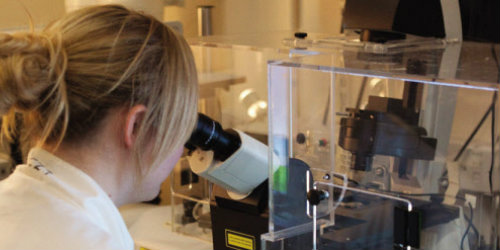New diagnostic tests for rare kidney disease
Red blood cell research identifies new tests for distal renal tubular acidosis (dRTA) - a potentially fatal kidney disease that can be treated with a spoonful of bicarbonate.
Distal renal tubular acidosis (dRTA) is a rare human disease in which specialised cells in the kidneys fail to secrete acid, which leads to calcium deposits in the kidneys, low blood potassium levels and metabolic bone disease.
If left undiagnosed, the disease will eventually cause death due to kidney failure. If detected, however, it can easily be treated with a simple dose of bicarbonate.
To date, only a small number of patients – approximately 20 families – of European origin, are known to be affected with the dominant form of the disease. A recessive form of the disease is more prevalent in South East Asia.
In 1997, University of Bristol researchers led by Professor Michael Tanner in collaboration with Clinicians at University College London were the first to identify the molecular basis for the disease.
They identified a number of specific mutations in a gene – known as the band 3/Anion Exchanger 1 gene – that codes for a protein which helps the efficient transport of gases in red blood cells and maintaining a healthy acid/base balance in the kidneys.
These mutations are the cause of the most common forms of dRTA known to date. This was confirmed by other researchers in Canada, Thailand and more recently China.
This information has been critical to clinicians as it provides them with a specific diagnosis and treatment plan for their patients.
Further research by the Bristol group led by Dr Ashley Toye, a Senior Lecturer in the School of Biochemistry and a NHS Blood and Transplant Principal Investigator, revealed further insights into the molecular mechanisms behind this rare disease, demonstrating that these mutations cause band 3 to become stuck inside the kidney cell or targeted to the wrong membrane.
The Bristol-based research, alongside that of other researchers at University of Cambridge and elsewhere, led to the adoption of new diagnostic tests for suspected dRTA patients. A nationally approved test became available in June 2011, which screens for common AE1 mutation sites and full genetic analysis is now provided for NHS clinicians to confirm or identify specific AE1 gene mutations.
The Bristol group (Toye and Dr Lesley Bruce who now located in NHSBT Filton, Bristol) work directly with clinicians, which is leading to diagnosis of the disease and therefore improved outcomes for patients.
They identified a gene mutation in a patient who had a rare anaemia that caused red blood cells to be prematurely destroyed and removed from the blood stream.
At the time this was only the second recorded occurrence of a patient having both the rare anaemia and dRTA.
Identification of the AE1 mutation led to an early diagnosis of dRTA, which is a more serious disease than the original anaemia being investigated. The patient was subsequently treated accordingly.
“Once the disease is identified,” said Toye, “it can be treated easily and cheaply. A spoonful of bicarbonate is all that is needed and the patients can then lead an otherwise normal life to a ripe old age.”

